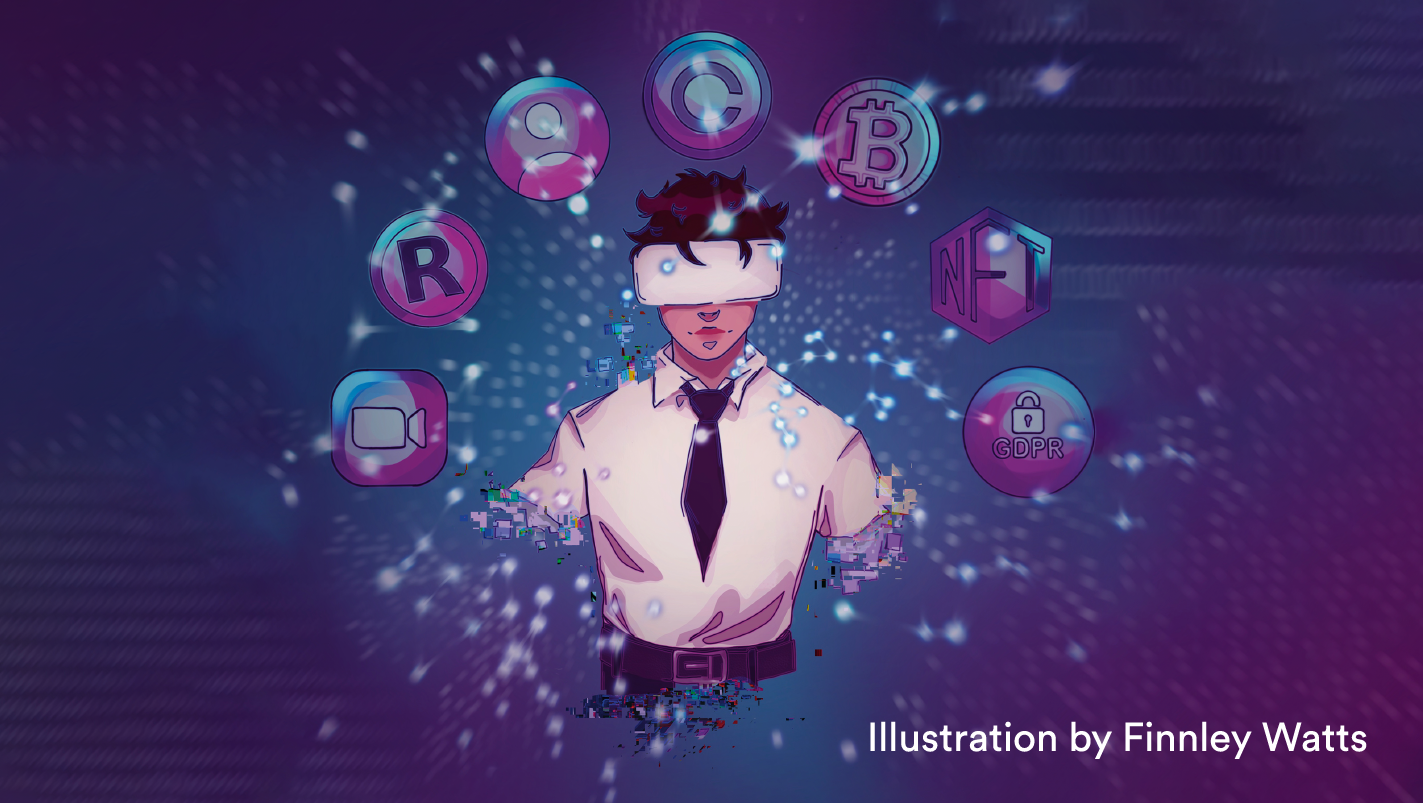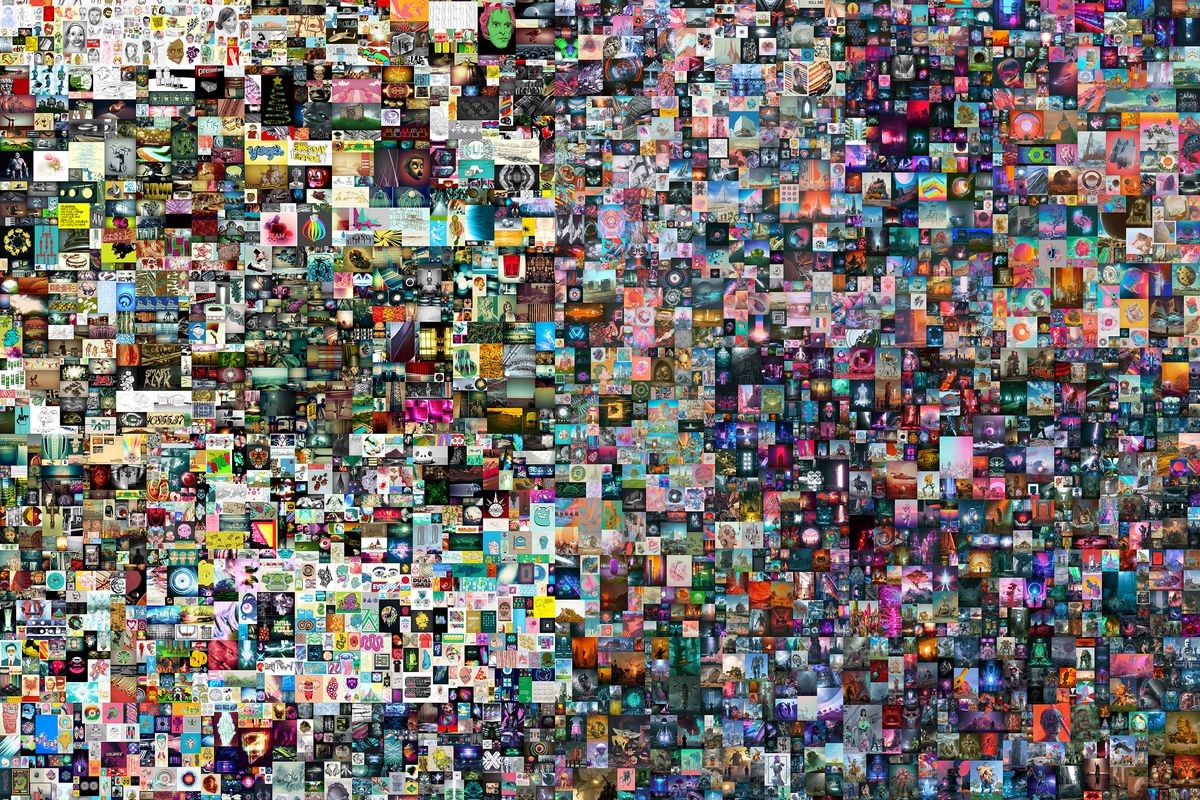NFTs in the metaverse
27.09.2022

Over the past two years, headline grabbing news about the astronomical sale prices fetched for newly minted “Non-Fungible Tokens” or “NFTs” from popular artists and content creators, has catapulted this new form of digital asset into the public consciousness across the globe. In March 2021 the digital artist Mike Winkelmann (known as ‘Beeple’) sold an NFT of his piece “Everydays: The First 5000 Days” for an astonishing $69 million! That sale, according to auction house Christies, positioned Beeple as “among the top three most valuable living artists” on the planet.
Public interest in NFTs has grown considerably since Christie’s auction of Beeple’s work, but so too has the debate about their purpose and utility. This third article considers the uses and purposes of NFTs, the role they could play in the metaverse and the legal risks and issues such use could raise.

Everydays: The First 5000 Days
NFTs – a record of ownership
As explained in the first article of this series, at its core, an NFT is simply a record of ownership of a specific unique digital asset, such as a jpeg or gif image or an audio or video file, stored and authenticated on a blockchain, usually Ethereum. In the case of Beeple’s work, the purchaser can irrefutably prove to be the sole owner of the NFT of the work, as the distributed ledger technology employed by the blockchain makes it near impossible for the purchaser’s record of ownership to be disputed or doctored because so many nodes in the blockchain can confirm that ownership.
The rights attached to ownership of each NFT can vary considerably from a simple non-exclusive non-commercial licence to display the digital asset publicly, to additional real world rights to physical goods and services and exclusive unlockable content. A key benefit for artists and content creators who mint NFTs, is that they can attach, in smart contracts associated with the NFT, an automatic re-sale royalty payment (usually a proportion of the cryptocurrency sale price of the NFT), which is triggered every time the NFT is re-sold.
Whilst NFT sceptics see little point or value in being able to claim ownership of a specific digital image or video which, in practice, could be copied or reproduced online in most cases with a simple press of the “Ctrl-C” buttons, NFT advocates point to the blockchain record as a digital certificate of authenticity, akin to buying a Picasso painting authenticated by art experts at MoMA in New York, as opposed to buying a cheap Picasso reproduction on Amazon. A Beeple NFT minted by the artist himself and authenticated on the blockchain is a status symbol for its owner, conferring the same bragging rights that a physical real world art collector would have were he/she to exhibit the original The Weeping Woman painting by Picasso on a wall in their home.
NFTs in the metaverse
One of the key problems for NFT owners is how to exploit those bragging rights. At the moment, NFT owners are fairly limited in the way they can show off their NFTs, which are stored in their digital wallets. An NFT in a digital wallet is often accessible primarily on a mobile phone app or the owner’s personal computer, but with the advent of the metaverse, showing off your digital artwork and collectibles to a wide audience of envious peers may be about to get a lot easier!
However you view the future evolution of the metaverse, whether it’s as an immersive 3D world accessed via your Meta Quest VR headset, a more interactive avatar centric evolution of social networking and online meeting places, or simply as an enhanced form of gaming like the next generation of Roblox or Fortnite, it’s very likely that NFTs will be at its core.
One of the key attractions for entrants to the new world of the metaverse is likely to be the high degree of customisation and personalisation that users can implement when they create their digital identity. This might include buying distinctive items of clothing that they will “wear” on their metaverse avatars, hanging unique artwork in their digital homes or personal meeting spaces, or kitting themselves out with accessories to carry when they interact with other users, which could range from a designer handbag to a bejewelled sword. As in the real world, it would be surprising if metaverse users did not choose to associate their new identities with fashionable and recognisable real life premium brands; a fact not lost on internationals brands such as Gucci and Burberry, each of whom has already offered NFTs of their products for sale. In December 2021 sportswear giant, Nike, also took the bold step of purchasing virtual shoe company “RTFKT” who makes NFTs and sneakers for the metaverse.
NFTs therefore provide an opportunity for individuals to buy authentic, premium, iconic and fashionable brands to associate with their life in the metaverse; however, before you go and purchase that million dollar NFT artwork to adorn the wall of your virtual home, or a Gucci purse NFT that will never leave the clutch of your avatar’s hand, it would be wise to consider some of the legal risks inherent in the NFT space.
The legal risks
One familiar real life problem that metaverse users will face, particularly when it comes to artworks, is the difficulty in distinguishing between NFT sellers offering genuine, authentic and original art in contrast to pieces that have simply been copied by a scammer looking to make a quick buck. Highly respected glitch artist, Rosa Menkman, publicly complained about such a problem, after she found five of her pieces being advertised and sold as NFTs on the OpenSea platform without her authorisation. While NFT marketplace platforms can de-list NFTs of plagiarised works, this will be of little consolation to buyers who spend their cryptocurrency thinking they’ve purchased a genuine digital artwork as an NFT, only to find it’s the equivalent of a forgery. The lesson here for buyers is to do thorough due diligence on NFT sellers and not rely on the platform to carry out this investigative work for them. OpenSea’s terms and conditions make this clear, stating that: “… you bear responsibility for verifying the legitimacy, authenticity, and legality of NFTs that you purchase from third-party sellers” (Section 5 – OpenSea Terms of Service, December 31, 2021).
Although recent case law in the English courts has gone some way towards recognising NFTs as property under English law (Osbourne v Persons Unknown and Ozone [2022] EWHC 1021 (Comm) (10 March 2022)), metaverse users who suffer a loss when dealing in NFTs are likely to find themselves faced with another problem, identifying the person to sue! Unlike an auction of artwork at Sotheby’s or Christies, where the purchaser or seller (an individual or organisation) can be identified relatively easily, the anonymity provided by digital wallets in blockchain transactions can make it extremely difficult for aggrieved parties to a transaction to initiate a claim.
Although blockchain technology in theory creates a clear record of each digital wallet which has held a particular NFT, tracing digital wallets (a string of numbers and letters) to their owners can be a tricky feat. Not only does anonymity jeopardise buyers obtaining remedies against fraudulent sellers of NFTs, but it also throws up an obstacle for artists or brands seeking to enforce NFT licence terms against subsequent downstream purchasers of their NFTs. If a buyer breaches a typical term of the NFT licence by, for example, using the NFT commercially or reproducing and re-selling the NFT of the artwork or digital item, then there is little that licensor can do to enforce those terms if they do not have a real person to take action against, and do not know the jurisdiction in which to commence proceedings.
The ability to connect a real life person with a virtual self and a digital wallet will be increasingly important within the metaverse as commerce and trade in this space (including via NFTs) begins to thrive. As our digital and real lives become increasingly intertwined, metaverse stakeholders will need to help join the dots between real individuals and their virtual selves, to ensure that people remain responsible and accountable for what their avatars may do, sell or own in this new virtual reality.
Still have questions? Be sure to read our metaverse articles below:
- Welcome to the metaverse: part one (definitions for a digital world)
- Welcome to the metaverse: part two (the metaverse’s past, present and future)
- Brand protection in the metaverse
- Advertising in the metaverse
- Copyright in the metaverse
- Taxation in the metaverse
- Competition/antitrust in the metaverse
- Jurisdiction and torts in the metaverse
- Reputation in the metaverse
- Online harms and safety in the metaverse
- Data protection in the metaverse
- Working in the metaverse – what employers need to know
Bristows Tech Summit 2022What should innovative technology companies be looking out for over the next year? Our team of leading experts tackled the most important legal and commercial issues facing the technology industry. |
Greg Ruback